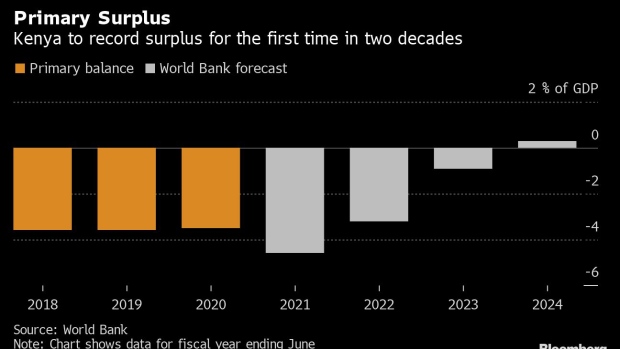Jul 1, 2021
World Bank Sees First Kenyan Primary Surplus After 20 Years
, Bloomberg News

(Bloomberg) -- Sign up for the New Economy Daily newsletter, follow us @economics and subscribe to our podcast.
Kenya could register a small primary surplus in 2023-2024, the first in two decades, buoyed by an economic recovery after the coronavirus pandemic, according to the World Bank.
The primary deficit, which excludes interest payments, could come in at 4.6% of gross domestic product in the fiscal year through June, and swing to a 0.3% surplus in 2023-24, the Washington-based lender said in a report. The fiscal deficit is projected to decline to 4.2% of GDP in 2023-24 from 8.7% in 2020-21 on consolidation efforts.
Achieving a primary surplus is an important debt-sustainability metric, as is reducing an economy’s debt-to-GDP ratio. In 2021, the primary deficit is expected to remain the largest contributor to Kenya’s debt-stock accumulation, according to the World Bank.
Interest payments rose by 0.2 percentage points to 3.1% of GDP in the third quarter of 2020-21, driven by domestic loans. The climb would have been steeper were it not for lower interest payments on foreign loans, as Kenya benefited from the Debt Service Suspension Initiative, the bank said.
“However, the risk of debt distress remains high as the Covid-19 pandemic has constrained economic growth, revenue collection, and exports, and delayed fiscal consolidation,” the World Bank said.
Other Highlights:
- East Africa’s biggest economy is projected to expand 4.5% in 2021 and 4.7% in 2022. The outlook, however, remains highly dependent on the course of the pandemic in Kenya and globally, the pace of vaccinations and the impact of containment measures.
- Revenue is expected to rise by 1.6 percentage points to 18.1% of GDP by 2023-24 from 16.5% in the period through June 2021, driven by new levies and a return to pre-pandemic tax rates.
- Expenditure is seen declining to 22.7% of GDP in 2023-24 from an estimate of 25.9% of GDP as at end-June, due to controlled recurrent spending.
- Kenya’s public debt is projected to increase to 69.5% of GDP in the fiscal year beginning Thursday from 68.6% of GDP in 2020-21, and decline marginally to 68.3% of GDP in the 2022-23 period.
(Updates with most recent surplus from first paragraph)
©2021 Bloomberg L.P.